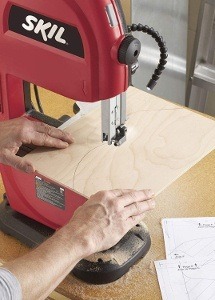
What is Resawing?
Resawing is the process of cutting a board into thinner pieces of the same length and width, and this also helps to open up a world of possibilities in woodworking.
Resawing lets you create wide panels from narrow boards, helps you get thin, malleable pieces for bent laminations, thin sheets of veneer, and it also turns logs into lumber.
Just like any woodworking skill we have out there today, you would need some time and a lot of practice to master the art of resawing.
Below are some tips on how you can effectively use Bandsaws for resawing:
1. Square the Bandsaw Blade and the Board: When you ensure that the blade is placed perpendicular to the table, you will find that this is very beneficial when you are resawing a wide board.
If you want to get the best results, you should raise the guidepost all the way and then you make sure to use an arm that will match the resaw capacity.
Next, you make sure to adjust the table so that there are no gaps between both the blade and the arm. Then you ensure that the board has a square corner. When you make this so, it will see to it that it will smoothly ride against the fence and the table during your cut.
2. Set the Bandsaw Fence at the Right Angle: If you want to make a straight cut on most bandsaws, you would need to angle the stock. This is what is called the “drift angle.” And finding this drift angle and, also setting the fence to match it is very important for when you are resawing.
You should start by making a straight line on the scrap board, keeping it parallel to its edge. When you do that, you follow the line, making a straight cut, making the board angled where necessary. Once you have cut far enough to the point you feel you have achieved the drift angle, you should hold the board in place and then transfer the angle to the saw’s table.
Use the marked line to position the fence at the same angle. Then you make test cuts, adjusting the fence as you deem necessary so you fine-tune the setup until the stock stays flush against the fence, without it drifting away from it.
3. Box in Long Boards: With this setup, resawing long boards is usually very seamless. And this is because it automatically holds up the board right against the fence so that your hands will be free to feed the board.
Make sure that the box is as tall as the board is wide, and it is about as wide as the distance between the blade and the table’s right edge. Place the box in front of the blade and clamp it so that the board fits well but is still able to slide between the box and the fence without it shaking.
4. Double Your Resaw Capacity: Imagine that you are trying to create a 24-inch wide book-matched tabletop, or that you are turning a 12-inch diameter log into lumber. Having a riser block on a usual 14-inch bandsaw will help increase its resaw capacity from 6 inches to 12 inches. You would need to check with the seller to know if they have the riser block as part of the kit for your saw.
This kit usually comes with the block and all the other parts that you would need to stretch your saw like the longer guidepost and the blade guard.
You should know that you will still need to get newer, longer blades, and if you have a bandsaw that bogs down easily when you have to resaw very wide boards, you may need to install a larger motor so that it can take care of the increased workload.
RELATED ARTICLES
Latest Articles
 The Strategic Value of Purchasing FontsIn TipsApril 18, 2024In today’s visually driven world, fonts are more […]
The Strategic Value of Purchasing FontsIn TipsApril 18, 2024In today’s visually driven world, fonts are more […] Revolutionizing Business: How AI Transforms Customer Experience in the Inflatable IndustryIn BusinessApril 16, 2024Inflatable water slides are the epitome of summer fun, […]
Revolutionizing Business: How AI Transforms Customer Experience in the Inflatable IndustryIn BusinessApril 16, 2024Inflatable water slides are the epitome of summer fun, […] Most Asked Microservice Interview Questions For 2024In TechnologyApril 2, 2024To keep up with changing trends in the tech industry […]
Most Asked Microservice Interview Questions For 2024In TechnologyApril 2, 2024To keep up with changing trends in the tech industry […] Best JavaScript and CSS Library In 2024In TechnologyApril 2, 2024With the ever-expanding functionality of web […]
Best JavaScript and CSS Library In 2024In TechnologyApril 2, 2024With the ever-expanding functionality of web […] Front-End Development Trends to Follow in 2024In TechnologyApril 2, 2024For better engagement, the front-end development of […]
Front-End Development Trends to Follow in 2024In TechnologyApril 2, 2024For better engagement, the front-end development of […] Simplifying Mealtime: Meal Prepping for a Family of FourIn UncategorizedMarch 22, 2024In the hustle and bustle of daily life, planning and […]
Simplifying Mealtime: Meal Prepping for a Family of FourIn UncategorizedMarch 22, 2024In the hustle and bustle of daily life, planning and […] How to Freeze Dry Candy With And Without a Machine?In FoodFebruary 27, 2024A candy lover constantly searches for novel and […]
How to Freeze Dry Candy With And Without a Machine?In FoodFebruary 27, 2024A candy lover constantly searches for novel and […] How to Get Something Out Of Your Eye Immediately?In healthFebruary 27, 2024Getting something inside your eyes can be frustrating […]
How to Get Something Out Of Your Eye Immediately?In healthFebruary 27, 2024Getting something inside your eyes can be frustrating […] The Evolution of Remote Control Technology: From RC Cars to DronesIn TechnologyFebruary 22, 2024Remote control technology has come a long way since […]
The Evolution of Remote Control Technology: From RC Cars to DronesIn TechnologyFebruary 22, 2024Remote control technology has come a long way since […] Unveiling the most popular carnival costumes: A colorful parade of creativityIn FashionFebruary 19, 2024In the world of festivities and merrymaking, few […]
Unveiling the most popular carnival costumes: A colorful parade of creativityIn FashionFebruary 19, 2024In the world of festivities and merrymaking, few […] Custom GPTs: The Next AI Opportunity for BusinessesIn Business, TechnologyFebruary 14, 2024The rise of artificial intelligence has transformed […]
Custom GPTs: The Next AI Opportunity for BusinessesIn Business, TechnologyFebruary 14, 2024The rise of artificial intelligence has transformed […] How to Get Rid of a Canker Sore in 24 Hours?In healthFebruary 13, 2024Canker sores are also called aphthous ulcers. They […]
How to Get Rid of a Canker Sore in 24 Hours?In healthFebruary 13, 2024Canker sores are also called aphthous ulcers. They […]
stopie.com is a participant in the Amazon Services LLC Associates Program, an affiliate advertising program designed to provide a means for sites to earn advertising fees by advertising and linking to Amazon.com.
Clicking on an Amazon link from stopie.com does not increase the cost of any item you purchase.
We will only ever link to Amazon products that we think our visitors may be interested in and appreciate learning more about.



